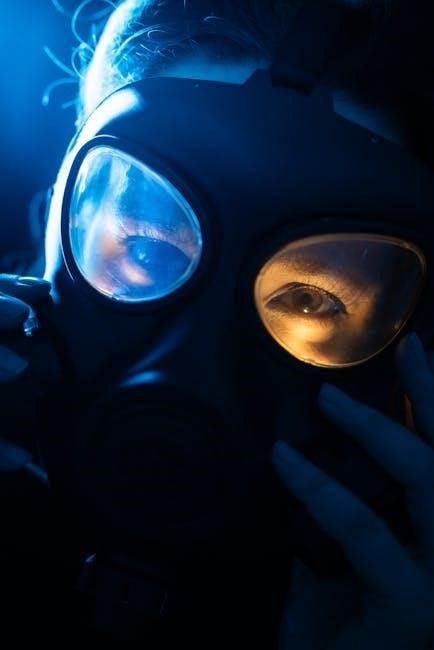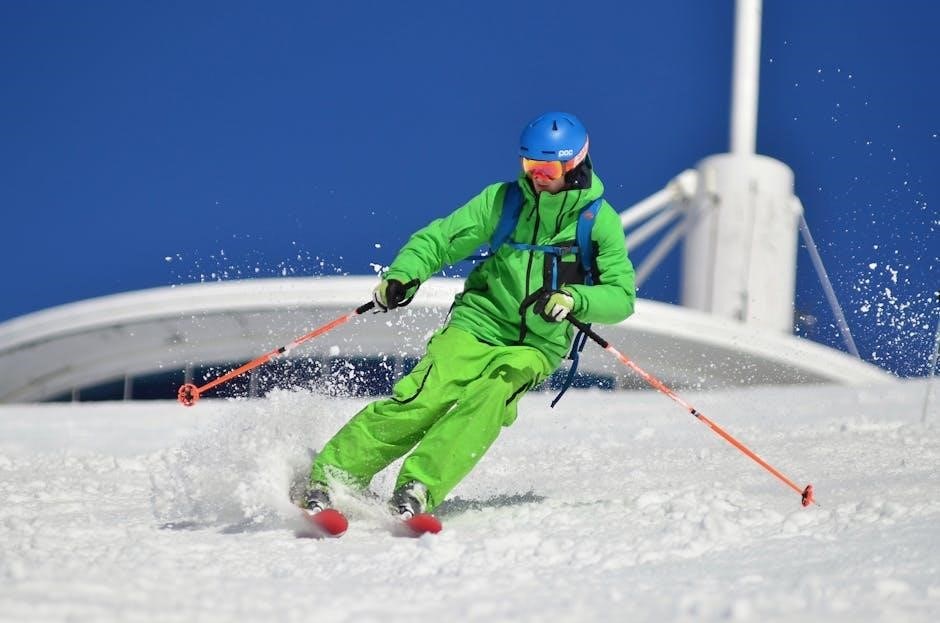This guide introduces the importance of ski goggle lens colors, helping you choose the right tint for optimal vision and performance in various snow conditions and lighting.
Importance of Lens Color in Ski Goggles
Lens color in ski goggles plays a crucial role in enhancing visibility, contrast, and overall performance on the slopes. Different tints are designed to optimize vision under varying light conditions, ensuring clarity and reducing glare. For instance, amber and yellow lenses improve contrast in low-light environments, while darker tints like gray and black are ideal for bright, sunny days. Rose and orange tints are favored for flat light and snowy conditions, as they heighten depth perception and terrain details. Proper lens color selection minimizes eye strain and improves reaction time, making it safer and more enjoyable to ski or snowboard. By choosing the right tint, skiers can adapt to changing weather and light, ensuring optimal visual acuity in any setting.
Overview of Light Conditions and Their Impact on Vision
Different light conditions significantly impact vision while skiing, influencing how skiers perceive terrain, depth, and obstacles. On sunny days, intense glare from snow can cause eye strain, reducing visibility and clarity. Overcast or cloudy skies often result in flat light, making it harder to distinguish terrain features and depth. Snowy or low-light conditions further obscure visibility, requiring enhanced contrast to navigate safely. Understanding these varying light scenarios is essential for selecting the appropriate lens tint. Each condition demands specific optical adjustments to maintain clear vision, ensuring better performance and safety on the slopes. By adapting to these environmental factors, skiers can optimize their visual acuity and enjoy a more immersive skiing experience.

Understanding Different Lens Tints
Understanding different lens tints is crucial for optimizing vision in varying light conditions. Each tint enhances contrast, reduces glare, or improves brightness, ensuring clearer visibility and safety on the slopes.
Yellow Lens Tint
Yellow lens tints are designed to enhance vision in low-light conditions, making them ideal for skiing in cloudy, snowy, or flat-light environments. These lenses improve contrast and depth perception, helping skiers better distinguish terrain variations. The brightening effect of yellow tints reduces eye strain and provides sharper clarity, especially in overcast weather. They are a popular choice for early morning or late afternoon skiing when natural light is limited. Yellow tints are often combined with mirror coatings or advanced technologies like ChromaPop to further enhance performance. This tint is particularly beneficial for skiers who frequent snowy or muted-light conditions, as it amplifies available light without distorting colors, ensuring a clearer and more defined view of the slopes.
Amber Lens Tint
Amber lens tints are highly versatile and perform exceptionally well in a variety of light conditions, making them a popular choice for skiers. These tints enhance contrast and improve depth perception by amplifying warm tones, which helps skiers better distinguish terrain features. Amber lenses are particularly effective in medium to bright light, as they reduce glare while maintaining clarity. They are ideal for sunny days on the slopes but also work well in cloudy or partly cloudy conditions. The amber tint enhances shadow definition, providing better visibility in mixed lighting. It’s a great option for skiers who want a balance between enhancing low-light visibility and managing brighter conditions. Many skiers prefer amber lenses for their ability to maintain natural color perception while improving overall visual acuity on the mountain.
Rose Lens Tint
Rose lens tints are excellent for flat light and overcast conditions, enhancing contrast and improving visibility in snowy environments. They work by amplifying available light while maintaining natural color accuracy, making them ideal for skiers who need better depth perception in low-light scenarios. Rose tints are particularly effective in reducing eye strain caused by flat light, where the horizon line is less defined. They are also versatile enough to perform well in moderate light conditions, providing clear vision without over-darkening the surroundings. Skiers often prefer rose lenses for their ability to enhance visual acuity in challenging light, while still offering a balanced view of the terrain. This makes them a great choice for skiers who frequently encounter changing weather and light conditions on the mountain.
Orange Lens Tint
Orange lens tints are designed to enhance contrast and improve visibility in low-light to moderate conditions, making them ideal for overcast or flat light environments. They work by amplifying available light while maintaining a balanced view of the terrain, which helps skiers detect subtle changes in snow texture and depth. Orange tints are particularly effective in reducing glare from snow and improving depth perception, which is crucial for navigating challenging terrain. They are also known to enhance visual clarity in cloudy or snowy conditions, making them a popular choice for skiers who frequently encounter variable weather. While they are similar to rose tints, orange lenses offer a slightly warmer tone that some skiers prefer for better visual comfort and performance in specific lighting scenarios.
Red and Pink Lens Tints
Red and pink lens tints are highly effective in enhancing contrast and visibility, particularly in flat light and snowy conditions. These tints work by amplifying the available light while reducing glare, making them ideal for skiers who often face challenging, overcast environments. Red tints are known for their ability to improve depth perception and reduce eye strain, while pink tints offer a slightly softer tone that enhances visual clarity without altering color perception too drastically. Both options are popular for their ability to highlight subtle variations in terrain, making it easier to navigate through powdery snow or icy surfaces. Skiers who frequently ski in low-light or mixed conditions often prefer these tints for their ability to maximize visibility and maintain sharp vision, ensuring better performance and safety on the slopes.
Copper and Brown Lens Tints
Copper and brown lens tints are popular for their versatility and ability to perform well in a wide range of light conditions. These tints enhance contrast by amplifying warm tones, making them ideal for both sunny and overcast days. They are particularly effective at reducing glare from snow while maintaining good color accuracy, which helps skiers perceive terrain details more clearly. Copper tints are known for their ability to highlight shadows, improving depth perception, while brown tints offer a balanced light transmission that works well in mixed lighting. Both options are suitable for skiers who need consistent visibility without excessive darkness, making them a practical choice for varying weather conditions on the slopes.
Grey and Black Lens Tints
Grey and black lens tints are designed for extreme brightness and sunny conditions, offering maximum protection against glare. These darker tints significantly reduce the amount of light that enters the goggles, making them ideal for skiing in intense sunlight, especially on snow-covered slopes. Grey lenses provide neutral color perception, while black lenses offer the darkest tint available, minimizing eye strain in bright environments. Both options are excellent for reducing glare from reflective surfaces like snow and ice. However, they are not recommended for low-light or overcast conditions, as they can make it difficult to see terrain variations. For skiers who frequently ski in sunny, high-altitude environments, grey or black tints are a practical choice for enhanced comfort and visibility.
Mirrored Lens Coatings
Mirrored lens coatings are a popular choice among skiers, offering both functional and aesthetic benefits. These coatings reflect light away from the eyes, reducing glare from snow and ice, especially in bright, sunny conditions. Mirrored lenses are available in various colors, such as silver, gold, and blue, and are often combined with other tints like grey or brown. They not only enhance visual comfort by minimizing reflections but also provide a stylish appearance. Mirrored coatings are particularly effective in high-altitude or sunny environments, where glare can be intense. However, they may not be ideal for low-light conditions, as they can further reduce light transmission. For skiers prioritizing glare reduction and a modern look, mirrored lenses are a versatile and practical option.

Weather-Specific Lens Recommendations
Weather-specific lens recommendations guide skiers to choose optimal tints for varying conditions, enhancing visibility in sunny, overcast, flat light, and low-light environments with tailored color options.
Sunny and Bright Conditions
For sunny and bright conditions, dark-tinted lenses such as gray, black, or mirrored coatings are ideal. These tints reduce glare from direct sunlight and protect your eyes from harsh UV rays. Gray lenses are particularly effective at maintaining true color perception while blocking intense light. Black lenses offer maximum light reduction, making them suitable for extremely bright environments. Mirrored coatings, available in colors like red or silver, further enhance glare protection by reflecting sunlight away from the eyes. These options are perfect for skiing in sunny, snow-covered terrain, where bright light can cause discomfort and impair visibility. By choosing darker tints, you ensure better eye comfort and sharper vision in high-light conditions. Additionally, some mirrored lenses incorporate advanced technologies like UV protection to safeguard your eyes fully.
Cloudy and Overcast Conditions
For cloudy and overcast conditions, lighter-tinted lenses such as rose, amber, or yellow are highly effective. These tints enhance contrast and improve visibility in low-light environments, helping skiers distinguish terrain variations more clearly. Rose and amber lenses are particularly popular as they provide natural color perception while boosting contrast, making it easier to spot changes in snow texture. Yellow tints are also excellent for cloudy days, as they brighten the surroundings and reduce flat-light conditions. These lighter tints ensure that skiers can maintain clarity and depth perception, even when the sky is overcast. By opting for these lens colors, skiers can improve their ability to navigate challenging, low-light terrain with confidence and precision. Additionally, some lenses incorporate advanced technologies to further enhance visual clarity in such conditions.
Flat Light and Snowy Conditions
Flat light and snowy conditions can make it difficult to see terrain features, but the right lens tint can significantly improve visibility. Yellow, orange, or rose-tinted lenses are ideal for these situations, as they enhance contrast and help skiers distinguish between snow textures and depths. These tints work by amplifying available light and reducing the washed-out effect of flat light, making it easier to spot subtle changes in the terrain. Amber and copper tints also perform well, as they enhance definition and reduce glare from snow. For extreme flat-light conditions, high-contrast lenses with advanced technologies like ChromaPop or PRIZM can provide superior clarity. These lenses are designed to filter out certain light wavelengths, enhancing visual acuity and depth perception. By choosing the right tint, skiers can maintain better awareness of their surroundings, even in challenging, snowy environments.
Low-Light and Nighttime Skiing
For low-light and nighttime skiing, lens color plays a crucial role in maintaining visibility and safety. Yellow or amber-tinted lenses are highly recommended, as they enhance contrast and improve depth perception in dimly lit conditions. These tints help to amplify available light, making it easier to see terrain features and obstacles. Clear lenses are also an excellent option for nighttime skiing, as they allow maximum light transmission without altering color perception. Additionally, mirrored coatings can reduce glare from artificial light sources, such as snowmaking equipment or resort lights. When skiing in low-light environments, opt for lenses with minimal tint to ensure optimal light entry; Swapping to a low-light-specific lens or using photochromic lenses that adapt to changing conditions can significantly enhance your skiing experience and safety during evening hours.

Universal and Versatile Lens Options
Universal lenses with medium copper, rose, or brown tints offer balanced light transmission, providing versatility across varying conditions while maintaining contrast and visibility for optimal skiing performance.
Medium Copper and Rose Tints for Variable Conditions
Medium copper and rose tints are excellent choices for skiers who encounter variable light conditions. These tints strike a balance between enhancing contrast and maintaining natural color perception, making them ideal for both sunny and overcast days. The medium copper tint subtly enhances definition, particularly in flat light, while the rose tint boosts depth perception and reduces eye strain. Both options are versatile, performing well in a range of environments, from cloudy skies to partly sunny conditions. They are particularly favored by skiers who need consistent visibility without extreme darkening or lightening of their field of view. These tints are also popular for their ability to improve clarity in snowy terrain, ensuring better reaction times and safer navigation on the slopes.
Brown Tints for Balanced Light Transmission
Brown tints offer a balanced approach to light transmission, making them a versatile choice for skiers. These lenses provide natural color perception while enhancing contrast, which is particularly beneficial in medium to bright light conditions. They are effective at reducing glare from snow and improving visual acuity, making them ideal for skiers who need sharp vision in varied environments. Brown tints are also known for their ability to maintain true-to-life colors, which helps skiers assess snow textures anddepths more accurately. While they may not offer the same level of low-light enhancement as rose or amber tints, they excel in providing consistent visibility and comfort across a wide range of lighting conditions, making them a practical option for skiers who experience fluctuating weather patterns on the slopes.

Additional Features to Consider
When choosing ski goggles, consider additional features like polarized lenses to reduce glare and photochromic lenses for adaptive tint changes, both enhancing vision and comfort on the slopes.
Polarized Lenses for Glare Reduction
Polarized lenses are a crucial feature in ski goggles, designed to significantly reduce glare from reflective surfaces like snow and ice. By blocking horizontally polarized light, these lenses enhance visibility and reduce eye strain, especially in bright, sunny conditions. This technology is particularly beneficial for skiers and snowboarders who frequently encounter harsh light reflections, as it improves clarity and allows for better depth perception. Polarized lenses are ideal for sunny and snowy environments, helping athletes spot terrain variations more easily. However, they may not be the best choice for low-light conditions, as they can darken the view further. Overall, polarized lenses offer a practical solution for reducing glare and enhancing visual comfort on the slopes.
Photochromic Lenses for Adaptive Tints
Photochromic lenses represent a breakthrough in ski goggle technology, offering adaptive tints that adjust automatically to changing light conditions. These lenses darken in bright sunlight and lighten in low-light environments, ensuring optimal vision and glare protection without the need to switch lenses. Ideal for skiers who experience varying weather and lighting throughout their day, photochromic lenses maintain consistent visual clarity. They eliminate the hassle of carrying multiple lenses, making them a convenient choice for active outdoor enthusiasts. With their responsive technology, photochromic lenses provide enhanced performance and comfort, adapting seamlessly to different snow conditions. This innovative feature ensures that skiers can focus on their terrain without distractions, making it a valuable addition to modern ski goggles.

Personal Preferences and Brand Technologies
Skiers’ preferences for lens colors vary based on visibility needs and brand innovations. Advanced technologies like ChromaPop and PRIZM enhance contrast and clarity, optimizing visual performance in all conditions.
Color Preferences and Visibility Needs
Ski goggle lens color preferences are highly personal, often influenced by individual visibility needs and skiing or snowboarding conditions. Some skiers prefer high-contrast tints like rose or amber for enhanced depth perception, while others opt for neutral tints such as grey or brown for truer color representation. Visibility needs vary depending on light conditions, with brighter tints excelling in low-light scenarios and darker tints reducing glare in sunny environments. Personal color preferences may also align with specific activities, such as yellow or orange tints for flat light and snowy conditions. Additionally, advanced lens technologies from brands like Oakley and Smith, such as PRIZM and ChromaPop, cater to individual preferences by enhancing clarity and contrast in varying light. Ultimately, choosing the right tint ensures optimal vision and performance on the slopes.
ChromaPop, PRIZM, and Other Advanced Lens Technologies
Advanced lens technologies like ChromaPop and PRIZM revolutionize ski goggle optics by enhancing color clarity and contrast. ChromaPop, developed by Smith Optics, filters specific wavelengths to amplify detail and reduce eye strain, making terrain features more distinct. PRIZM, by Oakley, fine-tunes vision by emphasizing certain light wavelengths, improving visibility in varying snow conditions. These technologies help skiers and snowboarders see nuances in terrain, such as bumps or shadows, with greater precision. Other innovations include photochromic lenses that adapt tint to changing light and mirrored coatings that reduce glare. These technologies combine with tint options to create lenses tailored for specific needs, ensuring optimal performance and visibility on the mountain.
